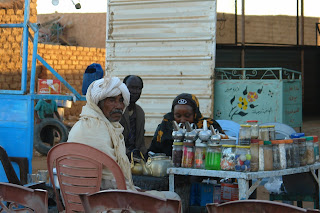

While waiting for the registration and permits we had a chance to have a quick peek at Khartoum. On our way to NCAM (the National Committee for Archaeology and Museums) we wandered down the corniche and saw where the White Nile meets the Blue Nile and you can really see a smaller strip of dark to north and a wider lighter area in the south. Unfortunately no pictures were taken because of nearby bridges (a big no no when it comes to photographing in Sudan) and because I didn't bring my camera along.
Ran into some other nice things tho. The little (well it's not so little but it looks that way) blue and white building known as Gadaffi's Egg. A deluxe hotel and business place built by the Libyans, the son of Moammar to be more exact.
And a company that has numerous activities and isn't afraid to announce it.
It's a very new city and has made space for buildings and streets. everything is wide. Houses are generally low. There aren't many shops although a new mall has been built recently. There are a lot of cars but nowhere near the amounts in Cairo and they don't honk very much.
The city itself is divided. Because of the inverted Y shape there's a series of cities. In the fork of the upside down Y is Khartoum 1, 2 and 3. Not very inventive or imaginary but very clear. The airport lies in the middle of these sprawling numbers. Streets in the newer parts have numbers, not names.
North of the fork is the northern area, usually designated industries and most likely garages etc. A few residential areas and lots of empty spaces. The area to the west/northwest is Omdurman with a large labyrinthian souq (as muslim cities should have, not the wide westernised shopping streets Luxor and Aswan now so falsely boast).
Omdurman is the part where the Ma'adi lived and is now entombed. For further reference; watch the movie "Khartoum" with Sir Laurence Olivier as the Ma'adi.

 The tarmac road almost went to Dongola (gotta love the names here). In Dongola we picked up our inspector, Abir, a slender and very kind Sudanese woman. Between her and our drivers (Saif and Aimad) it seemed there were very few people along the route they didn't know.
The tarmac road almost went to Dongola (gotta love the names here). In Dongola we picked up our inspector, Abir, a slender and very kind Sudanese woman. Between her and our drivers (Saif and Aimad) it seemed there were very few people along the route they didn't know.




